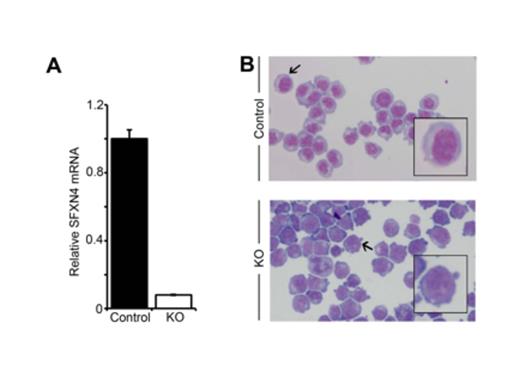Abstract
Megaloblastic anemia characterizes molecularly heterogeneous disorders, most commonly marked by macrocytosis, red blood cell enlargement, and abnormal nuclear maturation. Aside from vitamin B12 and folate deficiencies, genetic defects may be responsible for hereditary forms of megaloblastic anemia, though some remain unknown (Ghersim C, et al. 2013 J. Biol. Chem.). Loss of function of the gene Sideroflexin-4 (SFXN4) has been implicated as a cause for combined macrocytic anemia and mitochondriopathy. We have previously shown a defect in SFXN4 in humans and successfully modeled the erythroid and mitochondrial defects in the zebrafish (Hildick-Smith GJ, et al. 2013 AJHG). Here, we expand on prior studies involving SFXN4 in zebrafish and human fibroblasts by generating a murine cultured cell model deficient in SFXN4.
Clustered regularly interspaced short palindromic repeats (CRISPR)-cas targeting technology (Cong L, et al. 2013 Science) was utilized to generate SFXN4 knockout Friend mouse erythroid leukemia (MEL) clones. We conducted a screen of clones using qRT-PCR to select MEL clones with the lowest expression of Sfxn4 mRNA. The CRISPR knockout clone shows significantly reduced Sfxn4 mRNA relative to wild type (Panel A). Furthermore, the CRISPR knockout's reduced Sfxn4 mRNA is comparable to Sfxn4 mRNA levels in clones silenced by shRNA hairpin constructs (data now shown).
We also investigated the differentiation and maturation potential of the CRISPR-derived SFXN4 knockout clone. Initially, the MEL clone was differentiated for 3-5 days with DMSO treatment. o-dianisidine stains revealed that the CRISPR knockout clone had a reduction in hemoglobinization. Furthermore, Wright-Giemsa staining demonstrated that the same clone possessed megaloblastic features with immature maturation and a high nuclear to cytoplasmic ratio (Panel B). Both sets of results from experiments support the hypothesis for an essential role of SFXN4 in vertebrate red cell development.
No relevant conflicts of interest to declare.
Author notes
Asterisk with author names denotes non-ASH members.


This feature is available to Subscribers Only
Sign In or Create an Account Close Modal